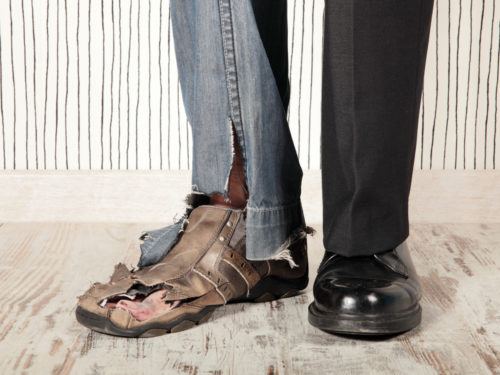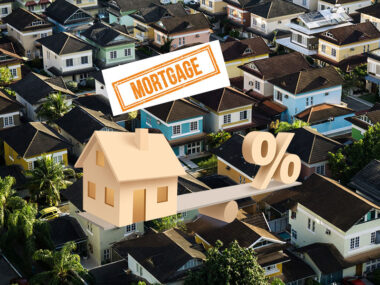A recent Economic Policy Institute (EPI) report estimated the 2017 CEO-to-worker compensation ratio in the United States to be 312-to-1. In comparison, in 1965 the ratio was 20-to-1. This indicates that economic disparity has greatly worsened in recent years.
Conversations about economic inequality often focus on disparities between different demographics. However, while economic inequality negatively affects minorities disproportionately, it is an even more sweeping issue. It’s important to keep in mind that the above statistic isn’t comparing the richest to the poorest; it’s comparing the richest to the average worker. The gap in income between the top earners in the U.S. and everyone else continues to grow, and we may be approaching a tale of class fallout as old as civilization.
Table of Contents
What Is Economic and Income Inequality?
At a glance, economic inequality and income inequality may seem like interchangeable terms. While they are similar, there are some key differences:
- Income inequality refers to a systematic or large-scale issue regarding the gap between different individuals’ or classes’ income that is deemed unjust or harmful.
- Income gap would refer to that divide without necessarily inferring any social commentary on its repercussions. It is also important to note that income inequality, as the phrase implies, specifically refers to income, rather than wealth.
- Wealth is a more general appraisal of all of a person’s accrued or available assets and resources, whereas income just refers to a person’s actively incoming assets.
- Economic inequality broadly refers to an unjust gap in assets. From a connotative standpoint, it may also be more likely to refer to inequalities between general groups of people, rather than specific groups or individuals.
Income Inequality in the United States
Based on the previously mentioned statistics, there is no doubt that a significant income gap exists between the wealthy and the middle class. However, questions of how that gap came to be and whether it is a problem that needs to be fixed involve more complex issues.
Measuring and Tracking Income Inequality
It’s difficult to determine exactly how problematic the situation has become. Although independent research groups like EPI have attempted to make estimates about the issue, there are fundamental gaps in the data. This is because CEOs are not required to publicly report their earnings until 2020, when the Dodd-Frank Act will take effect.
What little information the Census Bureau does release in terms of income inequality mostly does not include comparisons against top earners. The only recent data they have released that is even in the same ballpark uses the Gini ratio (also called the Gini coefficient), which was developed in 1912 and is highly controversial in terms of whether the data it provides is accurate or valuable.
Perhaps the worst failing of the Gini ratio is that it seeks to provide a tidy, simplistic, static answer to an incredibly complex problem that is caused by a multiplicity of issues and manifests in countless social symptoms. In fact, many modern census reports have been increasingly attempting to frame their economic inequality data within a multidimensional framework that takes many factors of advantages and assets into account.
Economic Mobility
Income inequality in the U.S. is not only a problem in of itself, but it also reinforces other unjust and/or discriminatory social trends due to poor economic mobility. According to research collected and analyzed by the Federal Reserve Bank of San Francisco, 44% of people born into the bottom economic quintile (bottom 20%) remained there. Similarly, 47% of those who were born in the top economic quintile (top 20%) remained there; only 7% of this group dropped to the bottom quintile.
This data is clearly at odds with the American dream. If all that mattered was how much someone worked, these economic groups wouldn’t be so stagnate. They would be more evenly distributed within some standard deviations. In fact, the Pew Research Center reported in 2015 that, “Approximately half of parental income advantages are passed on to children.”
Heritable Inequality
This trend is especially malignant for families who had to contend (and perhaps still contend) with systematic economic disadvantages. The aforementioned Pew Research data also found that the economic advantage conferred from parents to children benefitted men significantly more than women. Additionally, according to a report by the National Center for Children in Poverty, 27% of Latino children, 33% of black children, and 40% of American Indian children in the U.S. are poor, compared to 10% of white children.
Economic roadblocks continue to hinder minority income. Being born poor is an enormous roadblock to the degree that, even for generations after the obstacles are removed, minorities are still falling into the potholes left behind.
Causes of Economic Inequality
There are countless factors that may contribute to income inequality. One, as previously mentioned, is the heritability of income brackets. Some other heavy-hitters are debt, discrimination, and education.
Educational Attainment and Generational Wealth
The report from the Federal Reserve Bank of San Francisco noted that educational achievement largely counteracted the effects of intergenerational economic mobility for lower classes, but, unfortunately, educational achievement is also impacted by parental educational achievement.
According to a report from the Urban Institute, poor children whose parents completed high school or more had between an 11% and 30% better chance of graduating high school than did poor children whose parents did not finish high school.
Incarceration and Systemic Racism
Furthermore, the Brookings Institute reports that almost 70% of black men who did not graduate high school will end up in prison during their lifetime. This follows a trend of racial disadvantage, as well as institutional bias against the poor. To make things worse, the poor often do not have the resources to mount a decent legal defense or post bail once they are in jail, causing them to spend more time there.
For poor youth, being placed in juvenile detention or jail can be especially devastating to lifetime prosperity. Further data from the Brookings Institute estimates that juvenile incarceration decreases the chance of high school matriculation by 13% and increases the chance of future incarceration by 22%. On top of all of these issues, a criminal history makes it more difficult to get a job, and so the cycle continues.
Debt and the Poverty Cycle
Just as incarceration is a revolving door for the poor and disadvantaged, so is debt. Poor people are less likely to make a living wage that can cover basic things like housing, health insurance, and education, which means that they often end up in collections as a result of non-payment. This not only has a ruinous impact on their credit score, but it exacerbates an already terrible financial situation.
In some states, unpaid debt may even result in wage garnishment, which can actually legally knock the person’s wages below minimum wage.
Wealth Distribution in America
The cycle of debt in America does not only have a strong impact on the poor. Mounting educational costs are putting a significant faction of the younger generation into substantial debt to the tune of $1.5 trillion. Because of this scourge of debt, it could be said that the middle class is largely a facade.
Debt payment options may allow people in the middle class to spend their money in a more-or-less middle-class fashion, but, in reality, that lifestyle is precariously afloat on debt that easily may equate to more than they make in a year. Looking at it through this lens, does the middle class even really exist as we know it? Or is it just an imbalance of privilege and a mindset of wealth?
Theoretically, much of the modern middle class could be viewed as just a hidden lower class who have the luxury of continuing to spend and borrow. From this perspective, the gap between the top earners and everyone else would be even wider than what is usually estimated.
Solutions to Income Inequality
Unfortunately, there is just no cut-and-dried answer for these issues. However, there are several measures that have been proposed to help diminish income inequality.
Pay Equity
Raising the minimum wage is a hotly debated issue recently. Many are of the opinion that raising the minimum wage would be unfair to higher earners, make business management too costly, or cause inflation. On the other hand, beyond potentially reducing the income gap, raising the minimum wage may actually benefit the economy as a whole due to more people having more spending power, and as a result, businesses may see more cash flow.
Income Tax Reforms
On the other end of the class spectrum, another often-proposed solution is increasing the income tax for top earners. The opposition to this idea largely revolves around the theory that when the top earners make more money, so does everyone else. This theory is often called “trickle-down economics.”
Recently the Tax Cuts and Jobs Act (TCJA) — which cuts the earned income tax for corporations — was passed, largely based on a belief in trickle-down economics. However, if it were the case that the rich getting richer also benefited the less wealthy, one could assume that other wages would rise along with upper-class wages, and U.S. working wages have remained stagnant, even as the income of top earners surges upward.
Access to Opportunity
Generally speaking, possibly the best way to combat income inequality is increasing the availability of opportunities and resources for lower classes, especially in regards to safety and education.
Image Source: https://depositphotos.com/





